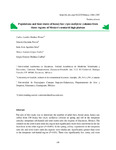
Please use this identifier to cite or link to this item:
http://ricaxcan.uaz.edu.mx/jspui/handle/20.500.11845/902Full metadata record
| DC Field | Value | Language |
|---|---|---|
| dc.contributor | 111167 | es_ES |
| dc.coverage.spatial | México | es_ES |
| dc.creator | Medina Flores, Carlos Aurelio | - |
| dc.creator | Guzmán Novoa, Ernesto | - |
| dc.creator | Aguilera Soto, Jairo Iván | - |
| dc.creator | López Carlos, Marco Antonio | - |
| dc.creator | Medina Cuéllar, Sergio Ernesto | - |
| dc.date.accessioned | 2019-03-28T20:28:53Z | - |
| dc.date.available | 2019-03-28T20:28:53Z | - |
| dc.date.issued | 2019 | - |
| dc.identifier | info:eu-repo/semantics/publishedVersion | es_ES |
| dc.identifier.issn | 2448-6698 | es_ES |
| dc.identifier.uri | http://localhost/xmlui/handle/20.500.11845/902 | - |
| dc.description.abstract | The aim of this study was to determine the number of adult bees, brood areas, honey and pollen from 150 honey bee (Apis mellifera) colonies in spring and fall in the temperate semidry, temperate sub-humid and semi-warm semi-dry regions of Zacatecas, Mexico. The colonies in the semi-warm semi-dry region had significantly more bees and brood in the fall than those in the other regions (P=0.001). In the spring, colony populations in the temperate semi-dry and semi-warm semi-dry regions were similar and significantly greater than those in the temperate sub-humid region (P<0.01). There was significantly less honey and more pollen stored in the fall, in hives of the semi-warm semi-dry region than in hives of the other regions (P=0.001). In the spring, the area of stored pollen in colonies of the temperate semidry region was significantly greater than that of colonies from the other regions (P<0.0001). The population of adult bees and brood areas of colonies in the fall correlated positively with bee population, brood and honey areas in the spring (P<0.001). In the fall, the semi-warm semi-dry region had better conditions for developing and reproducing colonies than the other regions. However, the population sizes of the colonies studied (21,000 to 35,000 bees/hive) are not considered optimal (>50,000), and thus, it is suggested that previous to blossom seasons, strategies aimed at increasing bee population and food stores, that contribute to winter colony survival and to improve their productivity, are implemented. | es_ES |
| dc.language.iso | eng | es_ES |
| dc.publisher | Instituto Nacional de Investigaciones Forestales, Agrícolas y Pecuarias | es_ES |
| dc.relation | https://cienciaspecuarias.inifap.gob.mx/index.php/Pecuarias | es_ES |
| dc.relation.uri | generalPublic | es_ES |
| dc.rights | Atribución-NoComercial-CompartirIgual 3.0 Estados Unidos de América | * |
| dc.rights.uri | http://creativecommons.org/licenses/by-nc-sa/3.0/us/ | * |
| dc.source | Revista Mexicana de Ciencias Pecuarias, Vol. 10, No. 1, pp. 199-211 | es_ES |
| dc.subject.classification | CIENCIAS AGROPECUARIAS Y BIOTECNOLOGIA [6] | es_ES |
| dc.subject.other | Apis mellifera | es_ES |
| dc.subject.other | Bee population | es_ES |
| dc.subject.other | Brood areas | es_ES |
| dc.subject.other | Honey | es_ES |
| dc.subject.other | Pollen | es_ES |
| dc.subject.other | Climatic regions | es_ES |
| dc.title | Populations and food stores of honey bee (Apis mellifera) colonies from three regions of Mexico’s semiarid high plateau | es_ES |
| dc.type | info:eu-repo/semantics/article | es_ES |
| Appears in Collections: | *Documentos Académicos*-- UA Veterinaría | |
Files in This Item:
| File | Description | Size | Format | |
|---|---|---|---|---|
| condiciones poblacionales-inglés.pdf | 395,92 kB | Adobe PDF |  View/Open |
This item is licensed under a Creative Commons License
